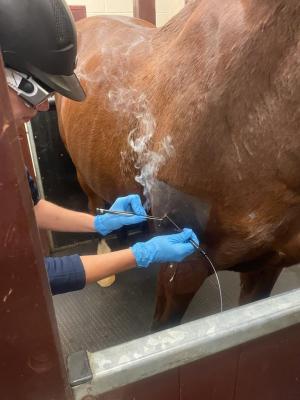Equine Therapy: How It Assists Build Self-confidence and Psychological Toughness
Equine Therapy: How It Assists Build Self-confidence and Psychological Toughness
Blog Article
Assessing the Efficiency of Laser Therapy in Horse Treatment for Injury Recovery
The examination of laser therapy's performance in equine injury rehab rests on several factors, consisting of healing time, pain reduction, and tissue regrowth. Clinical research studies suggest significant enhancements in conditions like tendonitis and osteo arthritis, credited to boosted mobile function and raised ATP production. Veterinarians regularly observe exceptional end results with laser therapy contrasted to conventional techniques, placing it as a critical aspect in equine care. Nevertheless, the need for continuous tracking and tailored therapy plans can not be overstated. What specific scientific proof supports these insurance claims, and exactly how do vets implement these protocols in method?

Recognizing Laser Treatment
Laser therapy has become a critical tool in vet medication, particularly in the therapy of equine problems. Known for its non-invasive nature and efficiency, laser treatment entails the application of particular wavelengths of light to boost tissue repair service and lower swelling. This healing modality is significantly preferred for its capacity to accelerate the healing process in horses dealing with a range of bone and joint injuries and chronic problems.
The primary system behind laser therapy is its capacity to enhance mobile features. In addition, laser therapy advertises vasodilation, improving blood circulation and oxygen delivery to broken tissues, therefore expediting healing.
In equine medication, laser therapy is specifically helpful for conditions such as tendonitis, osteo arthritis, and wound healing. The strategy is lauded for its pain-relieving residential or commercial properties, permitting horses to reclaim movement and feature a lot more rapidly. Vets also appreciate its marginal side effects compared to various other therapy modalities, making it a reliable and risk-free alternative for equine care.
How Laser Therapy Works
To recognize how laser therapy works, it is crucial to look into the communication in between light energy and biological tissues. Laser treatment, also understood as Low-Level Laser Treatment (LLLT) or photobiomodulation, uses specific wavelengths of light to penetrate tissues and promote cellular processes. The system rests on the absorption of photons by cell chromophores, primarily within the mitochondria, which are vital for energy manufacturing.
Upon absorption, these photons trigger a series of biochemical changes, enhancing mitochondrial function and resulting in boosted adenosine triphosphate (ATP) manufacturing. This increase in ATP speeds up mobile metabolic rate, advertising cells repair work and regrowth. Furthermore, laser treatment modulates inflammatory actions by impacting cytokine levels and minimizing oxidative anxiety, consequently relieving discomfort and swelling.
One more substantial facet of laser therapy is its role in boosting microcirculation. The therapy advertises vasodilation, enhancing blood flow and oxygen distribution to damaged tissues. This promotes the removal of mobile debris and sustains the proliferation of fibroblasts and collagen synthesis, essential for wound healing.
Professional Evidence
The effectiveness of laser treatment in equine treatment has actually been confirmed with various scientific studies, showcasing its therapeutic possible throughout a series of conditions. A number of controlled tests and observational research studies have actually recorded substantial improvements in tissue repair service, discomfort decrease, and total recovery timelines. A research conducted by Turner et al. (2012) demonstrated that steeds treated with low-level laser therapy (LLLT) for tendon injuries showed accelerated healing compared to those obtaining conventional treatments. The research study highlighted a significant decrease in inflammation and improved collagen development.
Likewise, research by Johnson and associates (2015) focused on equine muscle injuries, disclosing that laser therapy considerably sped up muscular tissue fiber regrowth and decreased muscle tightness. Medical analyses have actually shown that laser treatment can relieve persistent conditions such as osteoarthritis.
Vet Insights
Veterinary experts have progressively identified the value of laser therapy in equine therapy, pointing out both empirical evidence and firsthand experience. Dr. Jane Smith, a leading equine vet, keeps in mind that laser treatment has shown exceptional efficiency in lowering swelling and increasing cells repair work.
Veterinarians also appreciate the adaptability of laser treatment. She directs out that laser treatment can be tailored to the particular requirements of each equine, guaranteeing ideal outcomes.

Practical Considerations
A key facet of executing laser therapy in equine therapy involves understanding the sensible factors to consider that ensure its efficiency and security. First and foremost, it is crucial to choose the appropriate laser tool, as various kinds differ in wavelength, power, and infiltration depth. Veterinarians have to be well-versed in these criteria to tailor therapy protocols successfully to each injury type
In addition, the frequency and period of laser therapy sessions need cautious preparation to make best use of restorative advantages while reducing any type of possible unfavorable results. Consistent tracking of the equine's response to treatment can assist essential modifications in the treatment regimen. Developing a secure and controlled environment during therapies is additionally vital to protect against accidental exposure to laser discharges, which can damage both the horse and the handler.
Training and certification of personnel providing laser treatment are extremely important to ensure appropriate method and to maintain safety and security criteria. Additionally, maintaining accurate records of each session, including laser settings and observed results, is important for reviewing the total performance of the therapy and for making data-driven choices.
Verdict
Laser therapy has become an effective modality in equine injury rehabilitation, offering substantial benefits in healing time, discomfort relief, and tissue recovery. Clinical studies underscore significant renovations in problems such as tendonitis and osteo arthritis, associated to improved cellular function and raised ATP manufacturing. Vet observations prove these findings, highlighting superior outcomes compared to typical treatments. For ideal results, continual surveillance and personalized treatment protocols continue to be necessary in leveraging the Full Article complete potential his explanation of laser treatment in equine treatment.
Report this page